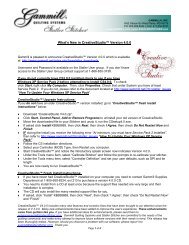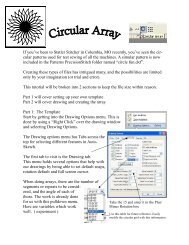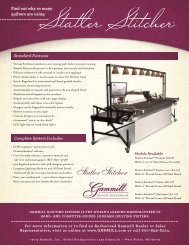Create successful ePaper yourself
Turn your PDF publications into a flip-book with our unique Google optimized e-Paper software.
Quilting the Quilt - Which CS Feature To use<br />
Phase 3 - Borders<br />
Side Borders<br />
Border patterns that are very detailed or contain stitch lines that are double stitched<br />
might look better if the quilt is reloaded sideways. This is a personal preference.<br />
Patterns that are very complicated or detailed (heirloom cables or feathers are good<br />
examples) don't hide size variations well, so do the main part of the quilt first<br />
(including the four corners, top and bottom borders) and turn the quilt.<br />
Here are some relevant Tips given in the previous sections about borders that are<br />
very important when doing side borders:<br />
(Borders in general)<br />
Tip: Draw a diagram of the entire quilt top for reference. Include<br />
the shape of the corner treatments. Accurately measure each border<br />
area noting the maximum size of the border. Subtract the space<br />
required for the margins and bindings and the remainder is the<br />
area to be stitched. Use the remainder as the target border<br />
dimensions for planning the initial pattern size, the number of<br />
rows and repeats.<br />
(Stitch Sequence)<br />
Tip: When doing side borders, be aware of the stitching sequence.<br />
Although it is tempting to 'flip' patterns so they fit the opposite side<br />
border, this can often reverse the stitch sequence. Grouping side<br />
patterns together and rotating them as a unit eliminates this<br />
problem.<br />
(Corners)<br />
Tip: It is possible to stitch the two corner patterns first IF you are<br />
sure that the repeat pattern for the border area will fit without<br />
further adjustments. A safer method is to add the images of the<br />
repeated border patterns into the preview area to see how they fit.<br />
(Butted Borders)<br />
Tip: It is always a good idea to see if all four borders are the same<br />
size. Minor differences (< 5-10%) can be handled easily. Significant<br />
differences require that each border be planned separately.<br />
(Custom Borders)<br />
Copyright © 2009 <strong>Gammill</strong>, Inc. | All Rights Reserved<br />
127





